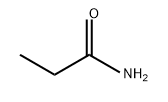Propionaldehyde , StandardforGC,>99%(GC) , 123-38-6
Synonym(s):
Propanal;Propionaldehyde
CAS NO.:123-38-6
Empirical Formula: C3H6O
Molecular Weight: 58.08
MDL number: MFCD00007020
EINECS: 204-623-0
PRODUCT Properties
| Melting point: | -81 °C (lit.) |
| Boiling point: | 46-50 °C (lit.) |
| Density | 0.805 g/mL at 25 °C (lit.) |
| vapor density | 2 (vs air) |
| vapor pressure | 18.77 psi ( 55 °C) |
| refractive index | n |
| FEMA | 2923 | PROPIONALDEHYDE |
| Flash point: | −16 °F |
| storage temp. | Store at <= 20°C. |
| solubility | soluble in chloroform; miscible with alcohol and ether |
| form | Liquid |
| color | White |
| Specific Gravity | 0.815 (20/4℃) |
| Odor | at 0.10 % in propylene glycol. earthy alcohol wine whiskey cocoa nutty |
| Odor Type | ethereal |
| biological source | synthetic |
| explosive limit | 2.3-21%(V) |
| Odor Threshold | 0.001ppm |
| Water Solubility | 540 g/L (20 ºC) |
| Sensitive | Air Sensitive |
| Merck | 14,7823 |
| JECFA Number | 83 |
| BRN | 506010 |
| Dielectric constant | 18.9(17℃) |
| Exposure limits | ACGIH: TWA 20 ppm |
| Stability: | Stable. Highly flammable. Incompatible with oxidizing agents, strong acids, strong bases. |
| InChIKey | NBBJYMSMWIIQGU-UHFFFAOYSA-N |
| LogP | 0.59 at 25℃ |
| CAS DataBase Reference | 123-38-6(CAS DataBase Reference) |
| NIST Chemistry Reference | Propanal(123-38-6) |
| EPA Substance Registry System | Propionaldehyde (123-38-6) |
Description and Uses
Propionaldehyde is a volatile liquid substance which consists of one carbonyl group and its characteristic functional group. The main functional group is an aldehyde which classifies propionaldehyde in the carbonyls. The main trunk of this substance is a short aliphatic chain. The carbonyl group determines, to a large extent, its chemical properties and most importantly its nucleophilic property. Propionaldehyde is readily oxidized if in contact to oxygen and should therefore be stored under inert gases.
Propionaldehyde is produced by the oxo reaction of ethylene with carbon monoxide and hydrogen. n-Propyl alcohol is produced by hydrogenation of propionaldehyde, and propionic acid is made by oxidation of propionaldehyde.
n-Propyl alcohol is used as solvent in printing inks and as an intermediate in the preparation of agricultural chemicals. Propionic acid is used as a grain preservative as, for example, in preventing spoilage of wet corn used as animal feed. The use of propionic acid as a grain preservative is an alterna tive to drying by heating, which consumes fuel, and is considered mostly when fuel is expensive.
Safety
| Symbol(GHS) |    GHS02,GHS05,GHS07 |
| Signal word | Danger |
| Hazard statements | H225-H302+H332-H315-H318-H335 |
| Precautionary statements | P210-P280-P301+P312-P303+P361+P353-P304+P340+P312-P305+P351+P338 |
| Hazard Codes | F,Xi,Xn |
| Risk Statements | 11-36/37/38-R36/37/38-R11-41-37/38-20/22 |
| Safety Statements | 9-16-29-S9-S29-S16 |
| RIDADR | UN 1275 3/PG 2 |
| WGK Germany | 1 |
| RTECS | UE0350000 |
| Autoignition Temperature | 404 °F |
| TSCA | Yes |
| HazardClass | 3 |
| PackingGroup | II |
| HS Code | 29121900 |
| Hazardous Substances Data | 123-38-6(Hazardous Substances Data) |
| Toxicity | LD50 orally in rats: 1.4 g/kg; LC for rats in air: 8000 ppm (Smyth) |




